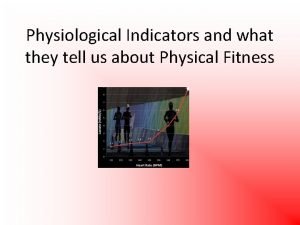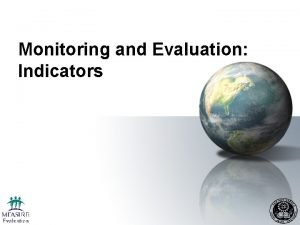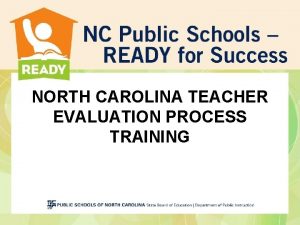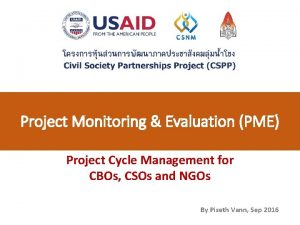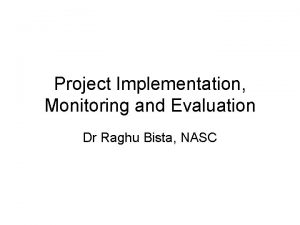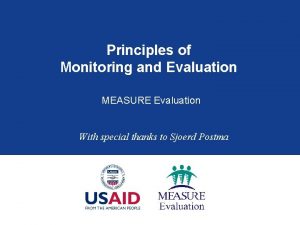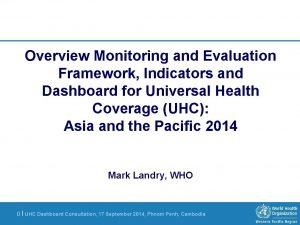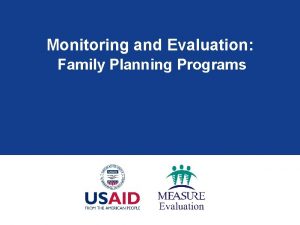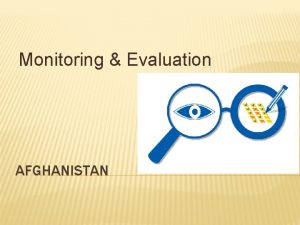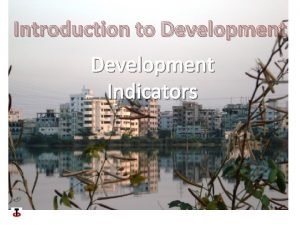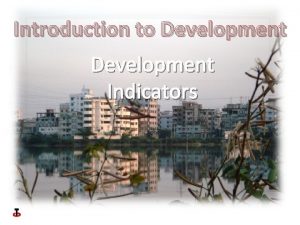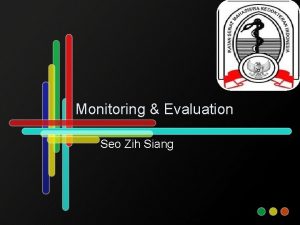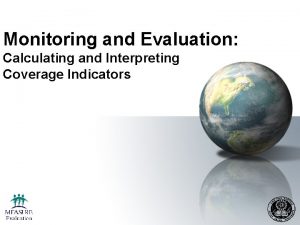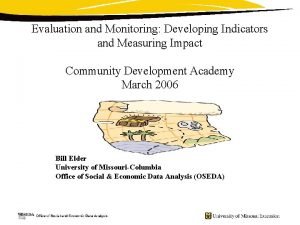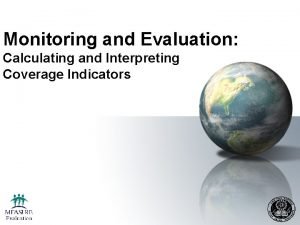Incorporating social indicators in the monitoring and evaluation















- Slides: 15

Incorporating social indicators in the monitoring and evaluation of environmental flows Lauren Zielinski Environmental Monitoring and Evaluation, LLC – USA Rebecca Tharme Riverfutures Limited – UK BRISBANE, AUSTRALIA | 18 - 20 SEPTEMBER 2017 MANAGED BY

Contents Definitions Why are social indicators important for M&E of eflows? Examples - Monitoring for social indicators Turning monitoring into management BRISBANE, AUSTRALIA | 18 - 20 SEPTEMBER 2017 MANAGED BY

Objective: A specific statement detailing the desired accomplishments, milestones, or outcomes of a project “To maintain a flow regime which allows for flood recession agriculture” Indicator: A units of information measured over time that document changes in a specific condition. An objective can have multiple indicators. “Amount of rice, maize, and native vegetables sold” Method: A specific technique used to collect data to measure indicators “Interviews with local farmers at the end of the growing season” “ Agricultural output in kilograms from local farmer cooperatives” DEFINITIONS – WHY SOCIAL INDICATORS – EXAMPLES – MONITORING INTO MANAGEMENT BRISBANE, AUSTRALIA | 18 - 20 SEPTEMBER 2017 MANAGED BY

“Environmental flows describe the quantity, timing, and quality of water flows required to sustain freshwater and estuarine ecosystems and the human livelihoods and well-being that depend on these ecosystems. ” DEFINITIONS – WHY SOCIAL INDICATORS – EXAMPLES – MONITORING INTO MANAGEMENT BRISBANE, AUSTRALIA | 18 - 20 SEPTEMBER 2017 MANAGED BY

Environmental Flow Assessment Environmental Flow Recommendations Environmental Flow Implementation • Establish mgmt. objectives • Create monitoring plan • Collect and evaluate data • Adaptively manage • Hydrological indicators • Ecological indicators • Social indicators DEFINITIONS – WHY SOCIAL INDICATORS – EXAMPLES – MONITORING INTO MANAGEMENT BRISBANE, AUSTRALIA | 18 - 20 SEPTEMBER 2017 MANAGED BY

Humans receive services from a system Humans have an impact on a system • • Changes in vegetation and land cover Nutrient and sediment pollution Abstraction of water resources Removal of animal, fish, and plant resources • • • Basic human needs Collection of animal, fish, and plants for subsistence Cultural and religious requirements Recreation Flood recession agriculture DEFINITIONS – WHY SOCIAL INDICATORS – EXAMPLES – MONITORING INTO MANAGEMENT BRISBANE, AUSTRALIA | 18 - 20 SEPTEMBER 2017 MANAGED BY

River systems are unique Social indicators should be unique Monitoring methods may also need to be unique DEFINITIONS – WHY SOCIAL INDICATORS – EXAMPLES – MONITORING INTO MANAGEMENT BRISBANE, AUSTRALIA | 18 - 20 SEPTEMBER 2017 MANAGED BY

“Traditional” Social Surveys • Interviews with local leaders or users of the river “Modern” Social Surveys: • Use of cell phone applications • Quantitative and qualitative data • Collection of different • Narratives are important media: • Comparison with hydrological and/or • Recorded interviews ecological indicators • Photographs and • Capable of capturing different types of data videos from local communities • Double check if other indicators and/or methods are appropriate • Notification of abnormal DEFINITIONS – WHY SOCIAL INDICATORS – EXAMPLES – MONITORING INTO MANAGEMENT conditions in real time BRISBANE, AUSTRALIA | 18 - 20 SEPTEMBER 2017 MANAGED BY

Rio Patuca – Traditional Ecological Knowledge • Interviewed local communities to understand how the river is important to fisheries, agriculture, and transportation • Identified social objectives and integrated with hydrological and ecological objectives to create environmental flow recommendations Esselman, P. C. , and J. J. Opperman. 2009. Overcoming information limitations for the prescription of an environmental flow regime for a Central American river. Ecology and Society 15(1): 6. [online] URL: http: //www. ecologyandsociety. org/vol 15/iss 1/art 6/ Photo credit: J. Opperman DEFINITIONS – WHY SOCIAL INDICATORS – EXAMPLES – MONITORING INTO MANAGEMENT BRISBANE, AUSTRALIA | 18 - 20 SEPTEMBER 2017 MANAGED BY

Combination with Other Indicators SOCIAL Ensure water is low enough to allow humans to cross safely SOCIAL Presence of fish species important for subsistence SOCIAL River system can support important recreation activities HYDROLOGY Water levels at river gauging stations ECOLOGY - FISH Monthly fish catch monitoring PARTNER AGENCIES Recreation data from a local park DEFINITIONS – WHY SOCIAL INDICATORS – EXAMPLES – MONITORING INTO MANAGEMENT BRISBANE, AUSTRALIA | 18 - 20 SEPTEMBER 2017 MANAGED BY

Combination with Other Indicators RUFIJI RIVER BASIN, TANZANIA Catch assessment survey (CAS) data DEFINITIONS – WHY SOCIAL INDICATORS – EXAMPLES – MONITORING INTO MANAGEMENT BRISBANE, AUSTRALIA | 18 - 20 SEPTEMBER 2017 MANAGED BY

Change Detection Using Remote Sensing • Changes in river basin characteristics • • Land use change Changes in vegetation types • Well suited for large areas or remote locations • Useful for long-term trends • Dependent on quality of images Teferi et al. 2010. The use of remote sensing to quantify wetland loss in Ethiopia. Hydrol. Earth Syst. Sci. , 14, 2415– 2428. DEFINITIONS – WHY SOCIAL INDICATORS – EXAMPLES – MONITORING INTO MANAGEMENT BRISBANE, AUSTRALIA | 18 - 20 SEPTEMBER 2017 MANAGED BY

Change Detection Using Remote Sensing Past: • Focused study area • Long time frame • Single comparison Future: • • GIS driven study areas Continuous analysis Short-term and long-term trends Increase in resolution = increase in capabilities Wohlfart et al. 2016. A River Basin over the Course of Time: Multi-Temporal Analyses of Land Surface Dynamics in the Yellow River Basin (China) Based on Medium Resolution Remote Sensing Data. Remonte Sens. 2016, 8, 186; doi: 10. 3390/rs 8030186 DEFINITIONS – WHY SOCIAL INDICATORS – EXAMPLES – MONITORING INTO MANAGEMENT BRISBANE, AUSTRALIA | 18 - 20 SEPTEMBER 2017 MANAGED BY

Turning Monitoring into Management • Social data is an important part of a holistic monitoring program • Helps to provide better understand of the “whole picture” • Data only useful if it’s actually used • Periodic evaluation of conditions • Act as a “trigger” for further investigation or management action • Direct inclusion of the concerns of the local users • Strengthens community engagement and involvement DEFINITIONS – WHY SOCIAL INDICATORS – EXAMPLES – MONITORING INTO MANAGEMENT BRISBANE, AUSTRALIA | 18 - 20 SEPTEMBER 2017 MANAGED BY

Thank you for your attention Lauren Zielinski lzielinski@ZEMEenviro. com BRISBANE, AUSTRALIA | 18 - 20 SEPTEMBER 2017 MANAGED BY
 Nn
Nn Incorporating the change
Incorporating the change Nested quotations
Nested quotations Incorporating pronunciation
Incorporating pronunciation Incorporating in ohio
Incorporating in ohio Capital budgeting chapter
Capital budgeting chapter Picme2.0
Picme2.0 Physiological indicators meaning
Physiological indicators meaning Evaluation indicators examples
Evaluation indicators examples Etsip
Etsip South carolina teacher evaluation system
South carolina teacher evaluation system Monitoring and evaluation in project life cycle
Monitoring and evaluation in project life cycle Comparison between monitoring and evaluation
Comparison between monitoring and evaluation Principles of monitoring
Principles of monitoring Monitoring and evaluation dashboard
Monitoring and evaluation dashboard Monitoring and evaluation of family planning programs
Monitoring and evaluation of family planning programs







